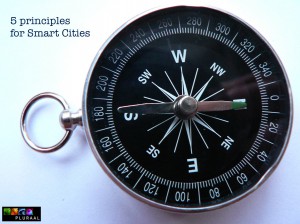 Most of you who are familiar with the concept of Smart City (however broad or narrow you define this), and you probably know several commentaries and models of subjects that are part of it. I follow my own classification based on the spatial part of cities. I will elaborate on this in a upcoming blog (next time), but before I will explore the different segments of my model, I would first like to state my personal principles that I consider essential. What is it you need to make a city smart?
Most of you who are familiar with the concept of Smart City (however broad or narrow you define this), and you probably know several commentaries and models of subjects that are part of it. I follow my own classification based on the spatial part of cities. I will elaborate on this in a upcoming blog (next time), but before I will explore the different segments of my model, I would first like to state my personal principles that I consider essential. What is it you need to make a city smart?
Based on what I read about current “smart city”-projects and mostly on the many conversations I had with professionals, scholars, professors and also with many friends, I singled out five principles for a smart city. These are:
- Think holistic!
- People as the centre
- No permanent solutions for temporary problems
- Dare to experiment!
- It’s a mutual world: bottom-up and top-down
1) Think holistic
Most projects (and people working on it) are focussed on one specific item. But there are many links between the several parts that constitutes a smart city. For instance, you need fast internet for smart public lighting and sensor technology. Or the use of electric cars can be enlarged if there is a smart electricity grid… Yet you see that in projects people working on it don’t see and use these existing links, they may miss opportunities. See and use the connections!
2) People as the centre
Technology is often leading. It’s used as the foundation of business models; it has to be profitable. But in my opinion it’s more important to look at how people use this technology: technology is a tool, a means and not an end in itself. Then the revenues will come. (See also my blog on design thinking)
3) No permanent solutions for temporary problems
We live in a very exceptional era; technology evolves faster than people and cities. So don’t try to invent permanent solutions for temporary problems, for cases which will be obsolete by the next morning. Try working with temporary answers based on contemporary technology that’s affordable and available. Acknowledge that you can’t keep up with technology, but use whatever there’s available for the time you need it.
4) Dare to experiment!
Even in this time of rapid inventions and soaring technology, people are looking for certainty and proven concepts. But many innovations are so new, we don’t know yet what will work and what won’t. We can only find out if we experiment: trial and error. I encourage everyone to do so: only actions give a result.
5) It’s a mutual world: bottom-up and top-down
There’s a debate going on between twee groups – do we innovate bottom-up (users) or top-down (companies/ government)? In my opinion we need both for a meaningful use of urban technology, to explore and to accomplish. It can only be done by cooperation with everyone involved; citizens, entrepreneurs, companies, colleges and public organisations. You need co-creation for the best results and you should use the energy that’s already there.
If you apply these five principles, you may not have the latest technology, the fastest 4G network or smart e-transfer, but you will have a strong and trustworhty foundation for a smart city. Why? Because you connect everything that’s happening while making sure you act with the actual (local) user in mind. And it’s not just one project on urban technology you work on, but you use this project in a strategic way, enabling a sustainable development – because it’s meaningful for both cities and people. Then, only then, the best things happen…

Leave a reply